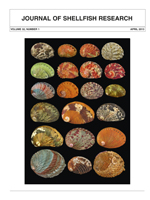Land-based grow-out of greenlip abalone (Haliotis laevigata) in Australia is predominantly practiced using a single-diet feeding strategy, despite geographical and seasonal differences in water temperature that influence feed intake and growth. This 12-wk study investigated the interactions between 2 abalone year classes (1 y old, 1.8 g; 2 y old, 22.9 g), 3 water temperatures (14°C, 18°C, and 22°C), and 4 dietary protein levels (1 y old: 27%, 30%, 33%, and 36% crude protein; 2 y old: 24%, 27%, 30%, and 33% crude protein) to evaluate the potential to use diets to suit specific water temperatures and aged animals. Diets were formulated to be isoenergetic (∼12.5 MJ/kg digestible energy), and contain fat levels of ∼3.6% and digestible protein levels ranging from 17.99%–28.57%. Feed was fed to excess daily and uneaten food was collected. Temperature significantly affected the specific growth rate of both year classes of abalone. There was no significant effect of dietary protein level on specific growth rate; however, abalone compensated for a reduction of dietary protein by consuming more feed. This observation was evident with significant increases in feed conversion ratios as dietary protein levels decreased for both year classes. With the exception of abalone grown at 14°C, when protein deposition decreased with increasing dietary protein level, protein deposition increased with an increase in dietary protein for both year classes. For 1-y-old abalone, as temperature increased from 14-22°C, the optimum crude dietary protein levels increased from -29%-∼35%. For 2-y-old abalone, the optimum crude protein level appeared to be less, and increased from 24% at 14°C to 34% at 22°C. There is scope to use multidiet feeding strategies in the production of greenlip abalone.
How to translate text using browser tools
1 April 2013
Dietary Protein Level and Water Temperature Interactions for Greenlip Abalone Haliotis laevigata
David A. J. Stone,
James O. Harris,
Hanru Wang,
Georgia J. Mercer,
Elise N. Schaefer,
Matthew S. Bansemer
ACCESS THE FULL ARTICLE

Journal of Shellfish Research
Vol. 32 • No. 1
April 2013
Vol. 32 • No. 1
April 2013
age
greenlip abalone
Haliotis laevigata
nutrition
Protein
temperature




